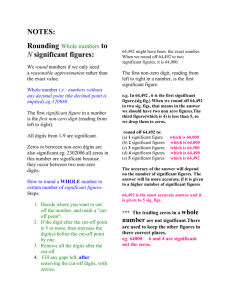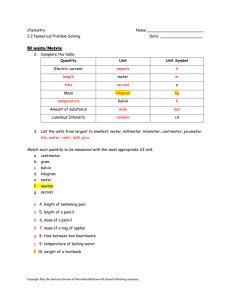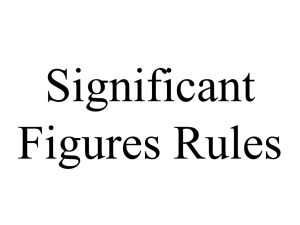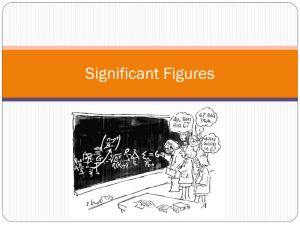Significant Figures: Rules & Examples
advertisement
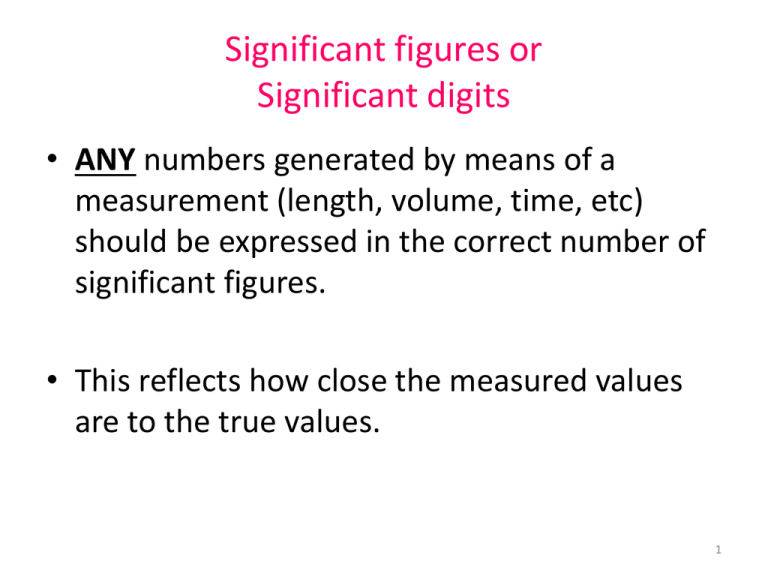
Significant figures or Significant digits • ANY numbers generated by means of a measurement (length, volume, time, etc) should be expressed in the correct number of significant figures. • This reflects how close the measured values are to the true values. 1 Significant Figures (digits) = reliable figures obtained by measurement = all digits known with certainty plus one estimated digit Taking the measurement • Is always some uncertainty • Because of the limits of the instrument you are using EXAMPLE: mm ruler Is the length of the line between 4 and 5 cm? Yes, definitely. Is the length between 4.0 and 4.5 cm? Yes, it looks that way. But is the length 4.3 cm? Is it 4.4 cm? • It is important to be honest when reporting a measurement, so that it does not appear to be more accurate than the equipment used to make the measurement allows. • We can achieve this by controlling the number of digits, or significant figures, used to report the measurement. As we improve the sensitivity of the equipment used to make a measurement, the number of significant figures increases. Postage Scale 3g 1g 1 significant figure Two-pan balance 2.53 g 0.01 g 3 significant figures Analytical balance 2.531 g 0.001g 4 significant figures Which numbers are Significant? How to count them! Non-Zero integers • Always count as significant figures 1235 has 4 significant digits Zeros – there are 3 types Leading zeros (place holders) The first significant figure in a measurement is the first digit other than zero counting from left to right 0.0045g (4 is the 1st sig. fig.) “0.00” are place holders. The zeros are not significant Captive zeros Zeros within a number at always significant – 30.0809 g All digits are significant Trailing zeros – at the end of numbers but to the right of the decimal point 2.00 g - has 3 sig. digits (what this means is that the measuring instrument can measure exactly to two decimal places. 100 m has 1 sig. digit Zeros are significant if a number contains decimals Exact Numbers Are numbers that are not obtained by measuring Referred to as counting numbers EX : 12 apples, 100 people Exact Numbers Also arise by definition 1” = 2.54 cm or 12 in. = 1 foot Are referred to as conversion factors that allow for the expression of a value using two different units Significant Figures Rules for sig figs.: •Count the number of digits in a measurement from left to right: •Start with the first nonzero digit •Do not count place-holder zeros. •The rules for significant digits apply only to measurements and not to exact numbers Sig figs is short for significant figures. Determining Significant Figures State the number of significant figures in the following measurements: 2005 cm 4 0.050 cm 2 25,000 g 2 0.0280 g 3 25.0 ml 3 50.00 ml 4 0.25 s 2 1000 s 1 0.00250 mol 3 1000. mol 4 Rounding Numbers • To express answer in correctly • Only use the first number to the right of the last significant digit Rounding • Always carry the extra digits through to the final result • Then round EX: Answer is 1.331 rounds to 1.3 OR 1.356 rounds to 1.4 Significant Figures Rounding off sig figs (significant figures): Rule 1: If the first non-sig fig is less than 5, drop all non-sig fig. Rule 2: If the first sig fig is 5, or greater that 5, increase the last sig fig by 1 and drop all non-sig figs. Round off each of the following to 3 significant figures: 12.514748 12.5 192.49032 192 0.6015261 14652.832 0.602 14,700
